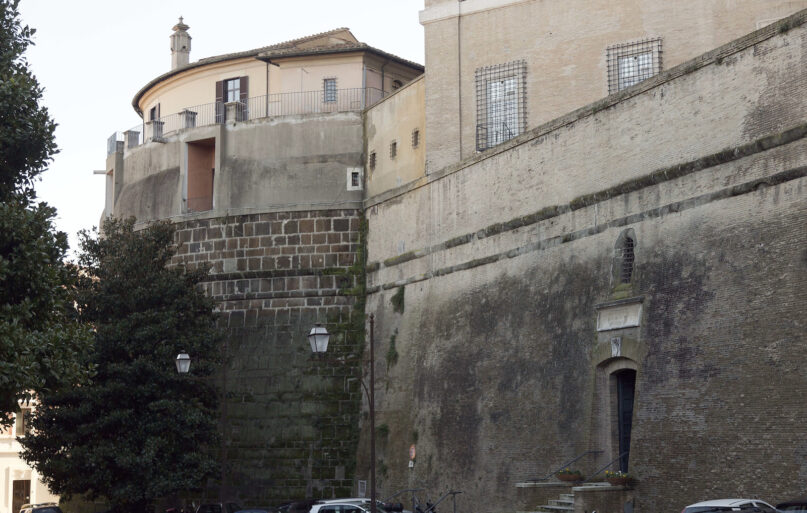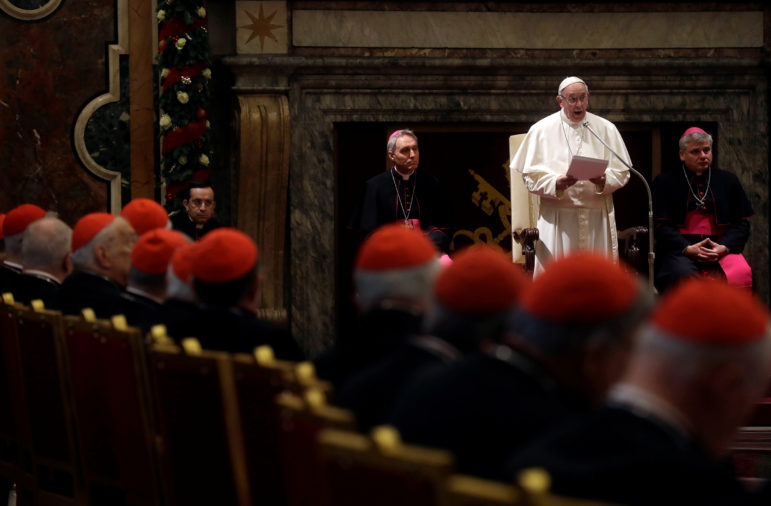
VATICAN CITY (RNS) — Pope Francis, known as a pastor dedicated to the poor and the marginalized, will also be remembered as a reformer who overhauled the Vatican’s troubled and scandal-ridden finances.
Francis had a two-pronged approach to financial reform: He carried out a technical program of restructuring Vatican departments and offices to eliminate redundancies, promoted transparency and introduced anti-corruption mechanisms, but he also believed true reform could only happen if the culture of Catholic institutions was radically overhauled.
This cultural shift was behind Francis’ adoption of synodality, a vision for the church that emphasizes dialogue and open doors while giving laypeople a greater voice. In 2021, the pope called for a three-year worldwide consultation of Catholics that resulted in two major summits of bishops, priests, members of religious orders and lay delegates at the Vatican in successive Octobers in 2023 and 2024.
“His reorganization of the Roman Curia and reorientation of its relationship with local churches was a structural expression of this ‘walking together’ and listening to what the Holy Spirit is saying to the churches,” said Sandie Cornish, a senior lecturer in theology at the Australian Catholic University and a member of the Vatican’s Dicastery for Promoting Integral Human Development, an agency created by Francis in 2016.
His practical reform measures began shortly after his election in 2013, with his selection of a council of cardinals to advise him on reform called the C9, and the establishment of a commission that included lay and ordained experts to help address the Vatican’s ailing finances. The next year he appointed Australian Cardinal George Pell to head the neawly established Vatican’s Secretariat for the Economy and a financial auditor, Libero Milone, to enact transparency reforms.

An exterior view of the offices of the Vatican bank in Vatican City, Jan. 28, 2014. (AP Photo/Domenico Stinellis)
Transparency was most needed in the Vatican bank, officially called the Institute for Religious Works, whose former president, Angelo Caloia, was put on trial and sentenced to more than eight years in prison in 2021 for money laundering and embezzlement.
The pope’s efforts were met with staunch resistance from Vatican bureaucrats. As infighting broke out, cardinals with differing visions of reform brought the process to a screeching halt at a vituperative meeting in Rome in February of 2015. “Behind a Papacy described as ‘revolutionary’ or ‘purifying,’ the same old gang war continues,” wrote Vatican expert Andrea Gagliarducci.
New scandals, meanwhile, further undermined Francis’ plans. In 2017, Pell was forced to return to Australia to face a trial on accusations of sexual abuse, and for more than a year, until he was found innocent on appeal, he was kept in solitary confinement. Almost simultaneously, Milone was unceremoniously ousted on charges of espionage, which were never proved and eventually dropped.
Milone accused Cardinal Angelo Becciu, then the Vatican’s third-highest ranking officer, of orchestrating his firing with the help of the head of the Vatican gendarmes, Domenico Giani. Milone told RNS that he and Pell had discovered that Becciu and others had spent Vatican charitable funds on an opaque $400 million investment in London real estate.
In 2022, Becciu and nine other defendants were found guilty by a Vatican tribunal, and the cardinal was sentenced to more than five years in prison for fraud and embezzlement. (Though Francis had stripped him of his rights as a cardinal in 2020, the Vatican said Tuesday (April 22) that Becciu is taking part in the preliminary meetings of cardinals ahead of the papal elections, and might even take part in the conclave.) Much of the $400 million was never recovered.

The London real estate property at the heart of the Vatican financial scandal. (Image courtesy of Google Maps)
As the “Vatican trial of a century” drew to a close, however, Francis moved with newfound energy to clarify financial lines of power. He stripped the Vatican Secretariat of State, which oversaw the London investment, of all its financial assets, implemented strict procedures for the acquisition of goods and services and centralized the Vatican investments and real estate management into the Administration of the Patrimony of the Apostolic See, or APSA.
He also dispatched a new Vatican auditor, Alessandro Cassinis Righini, and other trusted advisers to inspect the Curia’s books and replaced the leaders of several critical departments and the Catholic charity network, Caritas Internationalis.
By 2022, when the pope published a new apostolic constitution, “Praedicate Evangelium” (“Preach the Gospel”), to replace the governing document drafted by Pope John Paul II in 1988, many of the reforms it outlined had already occurred. At the same time, the Vatican bank received encouraging reports from the international anti-money laundering watchdog agency Moneyval. During the last years of Francis’ papacy, the bank and APSA published annual reports stressing the intention to comply with international financial standards.
While Vatican experts praised Francis’ work, they say the next pope has plenty more to do. “A lot of new rules have been introduced, but the questions remain whether they have really been implemented,” Milone said.
The church finances are still precarious, made worse by the lingering effects of the COVID-19 pandemic. Fewer visitors to the Vatican museums meant declining profits, while growing secularization reduces donations to the papal fund known as Peter’s Pence, which goes to support the Curia and its 5,000 employees — at a cost of nearly $900 million a year, according to Vatican reports — and the pontiff’s charitable works.
Donations from the world’s two wealthiest countries, the United States and Germany, declined toward the end of Francis’ pontificate, likely due to clashes over Francis’ policies, deemed too liberal by the former and too conservative by the latter.

Pope Francis speaks during the traditional greetings to the Roman Curia in the Sala Clementina (Clementine Hall) of the Apostolic Palace, at the Vatican on Dec. 22, 2016. (AP Photo/Gregorio Borgia, Pool)
The Vatican’s most recent budget report, from 2023, showed a $94 million deficit, barely covered by APSA’s positive gains. The employees’ pension fund is notoriously stuck in the red and has had to cut payments, despite Francis’ appointment of the papal chamberlain, Cardinal Kevin Farrell, to oversee its administration.
The pope cut the stipends of cardinals and urged Vatican officials to aim for a “zero deficit” regime. Among his last official acts was the creation of a commission of high-ranking Vatican officials to increase donations to Peter’s Pence on Feb. 27.
For Milone, the answer to the Vatican’s financial conundrums lies beyond its walls, saying that it can no longer rely on clergy who “were trained as priests, and (are) now asked to be accountants.” He added that to raise money, church leaders have to venture outside their “very small entity within a globalized world. If they want to find money, they need to understand what the world is thinking.”
Not everyone agrees that injecting lay expertise is the right answer. “The situation is not good, to say the least,” said Gagliarducci, but what the church needs are “Vatican people — the ‘old men of the old Curia’ that Pope Francis used to praise at the beginning of his pontificate. Once you get this mentality back on track, reforms will follow.”
Given the institution’s inability to offer competitive salaries for outside experts, Gagliarducci believes the Catholic institution should focus on the resources it already has. “A new pope will have to reemphasize the importance of working for the Vatican and provide new stimuli to the employees,” he said. “Somehow, the Vatican needs to get back to the old school.”
